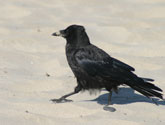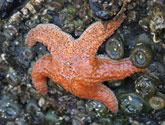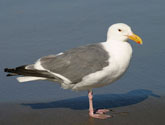
Home |
About Us |
How to Participate |
Biodiversity Modules |
Projects |
Maps |
News |
Resources

Home |
About Us |
How to Participate |
Biodiversity Modules |
Projects |
Maps |
News |
Resources
|
Definition of "Unvegetated" - General Code 100: Less than 10% vegetation cover. Excludes agricultural and, developed areas, and open water. Refers mostly to large areas of bare rock, saline flats, and permanent snow and ice fields. |
Unvegetated: Sand Beach (130)
 | Descriptive Habitat Code: Beaches are habitats having less than 10% vegetation cover (1), and include large areas of sand (30)
Photo: Haystack Rock at Cannon Beach, Oregon |
 American crow Corvus brachyrhynchus Code: COBR Photo: TFK |
Distribution and Habitat: It is found in a wide variety of natural and developed urban habitats. They can be seen in parks, camp grounds and along beaches. Diet: Interesting fact: |
 California gull Larus californius Code: LACAL Photo: RA |
Distribution and Habitat: It is found throughout parts of the western North Pacific Ocean. It breeds on gravel beds along the Columbia River and large lakes in the Columbia Basin. Diet: Interesting fact: |
 Sea star Code: Photo: TFK |
Distribution and Habitat: It is found throughout parts of the western North Pacific Ocean. Diet: Interesting fact: |
 Western gull Larus occidentalis Code: LAOC Photo: TFK |
Distribution and Habitat: It is found throughout parts of the western North Pacific Ocean. It breeds on gravel beds along the Columbia River and large lakes in the Columbia Basin. Diet: Interesting fact: |
Home |
About Us |
How to Participate |
Biodiversity Modules |
Projects |
Maps |
News |
Resources